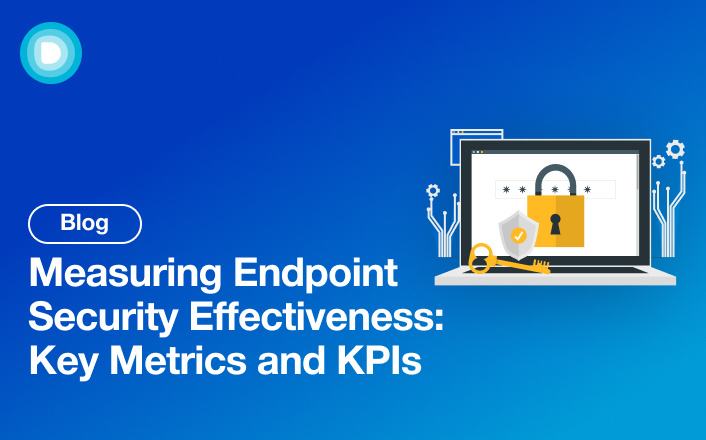- Product
-
Solution
-
By Industry
Cybersecurity solutions tailored to your industry’s needs.
-
- Resources
-
Books
Our ultimate guides and playbooks
Solution Briefs
Overview of PureDome’s functionality
-
Quizzes
Assess your cybersecurity readiness
Case Studies
PureDome customer success stories
Newsletter
Subscribe to the PureDome newsletter
-
- About Us
- Partner
- Pricing
- Download
Measuring Endpoint Security Effectiveness: Key Metrics and KPIs
-
Sharmeen Saleem
-
08 Aug 2024
- 3 min read


With the rapid increase in mobile device usage, ensuring your network is protected by endpoint security solutions has become essential. However, the biggest challenge with endpoint security solutions is determining whether these tools effectively serve their purpose. How can you be sure that your network is more secure than before?
Assessing the performance of these security tools can be difficult, primarily because you are often inundated with so much network-related information that you feel overwhelmed and may choose not to evaluate them at all. This would be a significant mistake.
Read on to learn how you can measure the effectiveness of your endpoint security solution.
What Endpoint Security Metrics Should You Track?

Threat Detection
The percentage of threats identified and reported by your endpoint security tools defines the threat detection rate. It reflects how adeptly you identify and prevent potential cyber-attacks on your endpoints. A high threat detection rate signals the presence of a responsive and robust endpoint security system capable of promptly alerting you to anomalies and malicious activities. To attain a high threat detection rate, opt for cutting-edge endpoint security solutions such as firewalls, antivirus, NDR, and EDR, which are proficient in detecting and blocking known and unknown threats.
Coverage
The coverage rate indicates the ratio of endpoints that have the most recent security updates, policies, and patches followed. It reflects how well you maintain your endpoint security compliance and hygiene and compliance. A low coverage rate denotes that you have vulnerabilities and gaps in your solution that attackers can exploit.
Endpoint Availability
The endpoint availability rate measures the percentage of endpoints that are operational and accessible at any given time. It reflects your ability to maintain the continuity and reliability of your endpoint services. A low endpoint availability rate suggests performance issues, downtime, or disruptions that can affect productivity and customer satisfaction. To achieve a high endpoint availability rate, focus on monitoring endpoint health, usage, and performance and optimize capacity and resources accordingly.
Threat Response
The threat response rate is the percentage of threats remediated and fixed by your endpoint security teams or solutions. It indicates your company’s effectiveness in responding to and recovering from attacks on your endpoints. A high threat response rate signifies the presence of an efficient and rapid incident response strategy within your endpoint security framework, capable of containing and minimizing the consequences of threats. To achieve this, prioritize establishing well-defined roles and responsibilities, adhering to industry best practices, and utilizing orchestration and automation tools.
ROI of Endpoint Security
Endpoint security ROI measures the benefits relative to the costs of your endpoint security investments. It indicates how effectively you achieve security goals while optimizing your budget and resources. A high endpoint security ROI demonstrates a positive and profitable outcome, optimizing your strategy and spending. To achieve a high endpoint security ROI, align your security efforts with business needs, evaluate the value and impact of your security measures, and regularly review and adjust your security plan.
Here’s what else to consider to measure the effectiveness of your endpoint security solution.
You should go for security products that offer exceptional value in both cost efficiency and security effectiveness. This effectiveness is determined by the technology's ability to deliver, at a minimum, the following three core capabilities:
Performance & Functionality
Does the technology effectively perform its intended security function?
Malicious executables (malware) and vulnerability exploits are two primary attack vectors used to compromise endpoints. Effective endpoint security solutions must prevent malware and exploits from compromising endpoints and servers. Additionally, they must be capable of thwarting known and unknown variants of these threats.
Flexibility
Does it adapt to protect and accommodate new systems, platforms, and applications?
Several decades ago, cyberattacks were infrequent and less sophisticated. Endpoint security tools were primarily designed to prevent viruses from infecting systems. However, today's threat landscape is vastly different, relegating traditional endpoint security tools like antivirus to reactive detection and response roles. Security products must adopt a proactive approach to protect endpoints adequately.it is imperative to prioritize prevention to minimize the severity and frequency of cyber breaches.
Inherent Resilience
Does it effectively deter attackers and users from circumventing its security measures?
No security technology or platform is designed to be easily circumvented. If attackers or end users can bypass the technology's intended function, it fails to serve its ultimate purpose. A robust endpoint security platform should prevent attackers from bypassing security measures and should not cause performance issues that prompt users to disable it.
Conclusion
When evaluating endpoint security effectiveness through key metrics and KPIs, you must prioritize selecting a robust solution. It should effectively combat diverse threats while minimizing false positives and system impact. By monitoring the aforementioned metrics, you'll gain insights into your security's efficacy. Continuously refine your strategy to stay ahead of evolving threats and strengthen your overall security resilience.